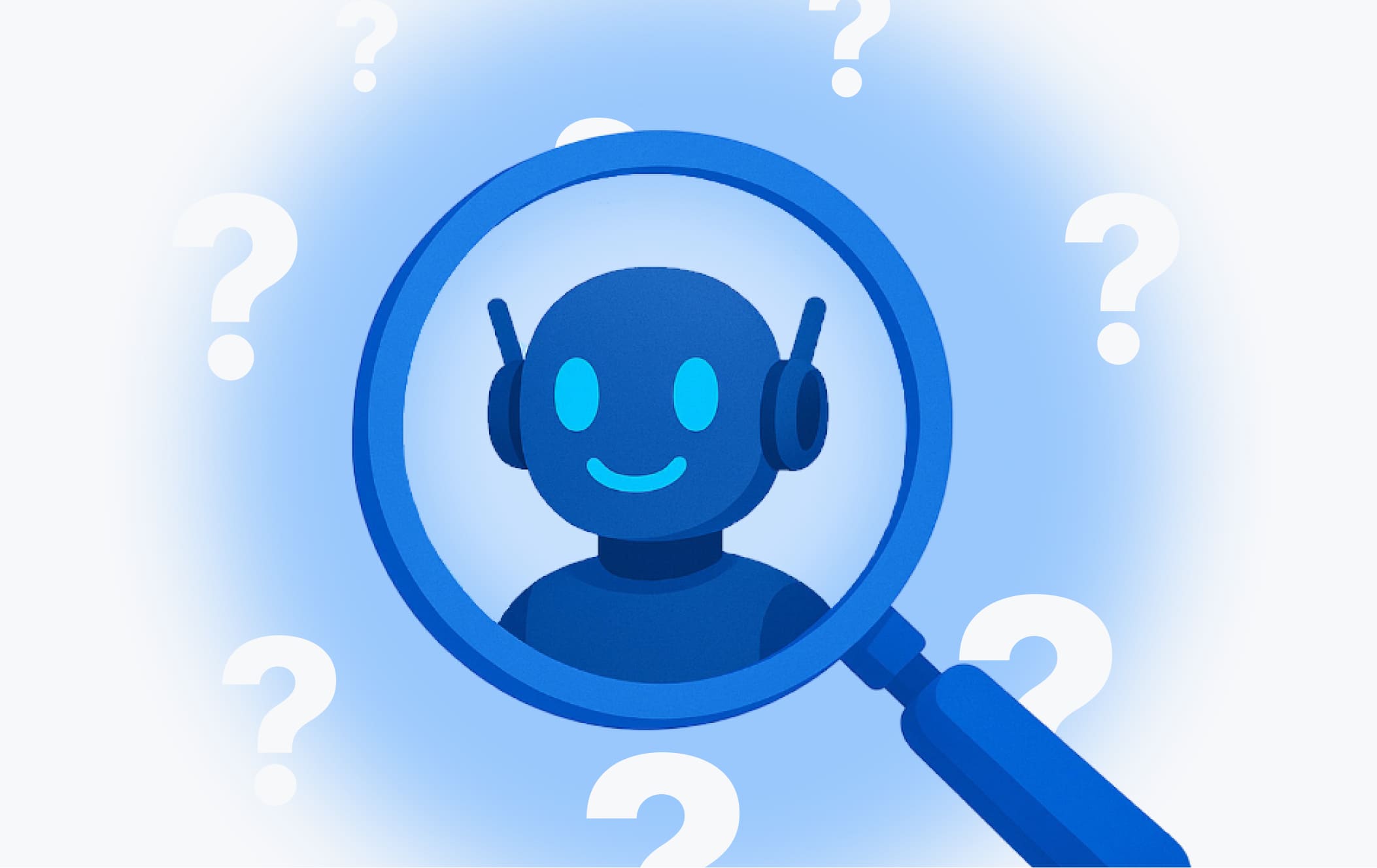User Adoption Strategies: Training Employees and Customers to Use AI Agents
AI adoption challenges often stem from more than just technical issues—they’re human ones. This guide explores how to overcome these challenges with proven strategies for training employees and customers to confidently use AI agents.

Implementing AI agents, whether internal assistants for employees or customer-facing chatbots, can significantly enhance productivity, streamline operations, and boost customer satisfaction.
Yet, despite these clear benefits, many enterprises face considerable AI implementation challenges in getting users to adopt new AI tools effectively.
So, how do you overcome these challenges and ensure successful adoption? Here’s your guide to practical strategies for training employees and customers.
Fewer than one-third of companies actively follow most recommended practices for AI adoption and scaling, such as establishing clear KPIs, roadmaps, and dedicated adoption teams. McKinsey & Company
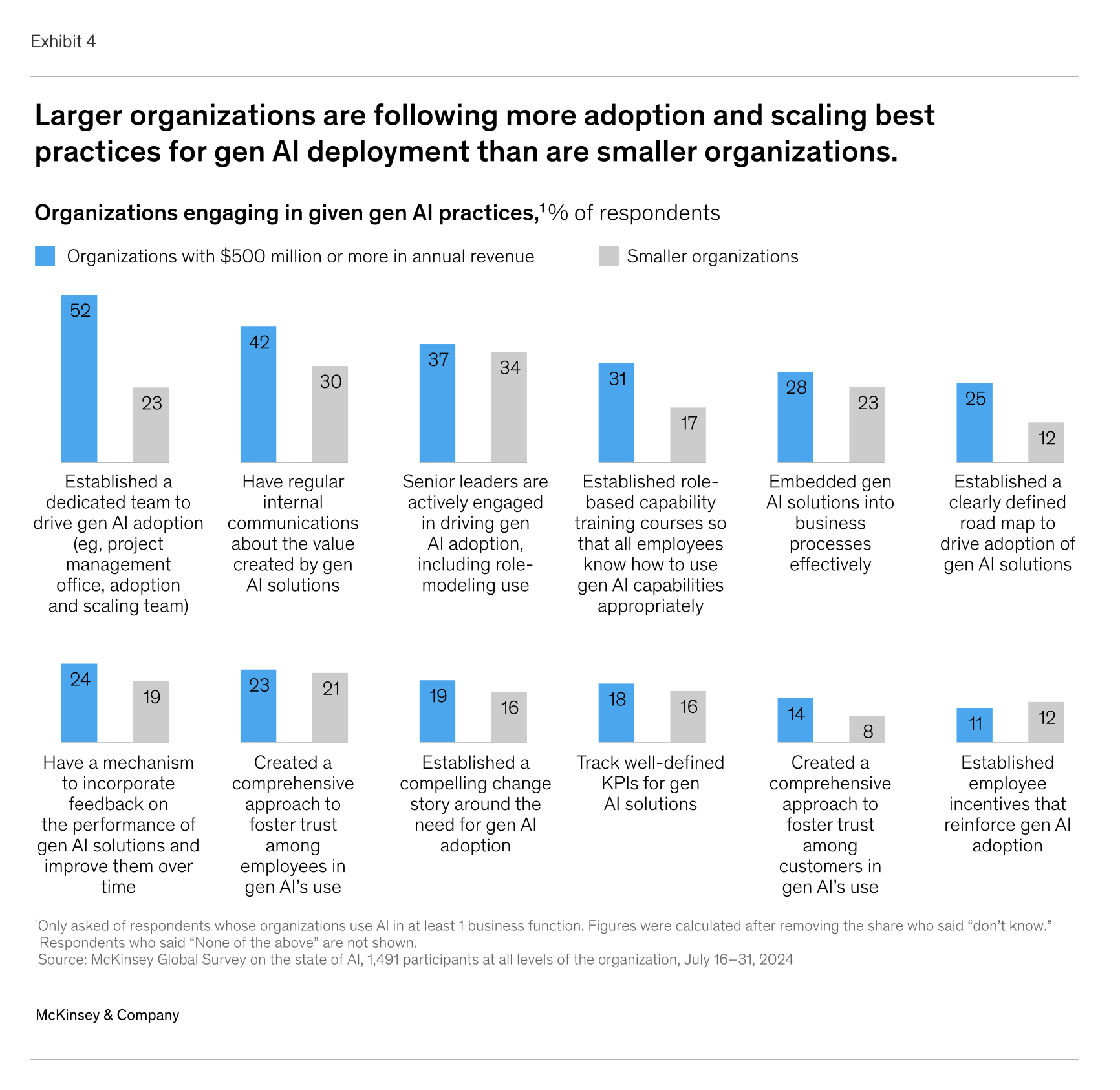
Understanding AI Adoption Challenges in Organizations
Adopting AI is not merely a technical implementation—it is fundamentally a human challenge.
Organizations often encounter people-centric obstacles such as employee anxiety around AI’s impact on jobs (with 75% worried AI could render their roles obsolete) and customer hesitation toward interacting with automated agents. If users don't embrace these AI solutions, the expected ROI and efficiency improvements will fail to materialize.
Successful AI implementation involves navigating several critical AI adoption challenges:
1. Lack of strategic vision or leadership buy-in
Clear strategic vision and committed leadership are essential. AI initiatives often stall when executives fail to clearly define goals or secure necessary support.
McKinsey reports that companies with active CEO involvement in AI governance significantly outperform those without, yet only 28% of organizations currently have this high-level oversight. Establishing dedicated AI transformation teams and a compelling change narrative can align stakeholders and enhance executive commitment.
Companies see better results when CEOs or boards actively oversee AI governance. This oversight correlates strongly with positive bottom-line impacts. About 28% report CEO involvement in AI governance. McKinsey & Company
2. Employee resistance and fear
Employee resistance often stems from mistrust, existential questioning, or perceived inefficiencies, as outlined in a ScienceDirect study. These manifest as fears of job displacement, loss of control, or ethical concerns about AI decisions.
In late 2023, 71% of US employees reported concerns about AI at work. This fear of the unknown or loss of control can lead to pushback or low engagement if not addressed.
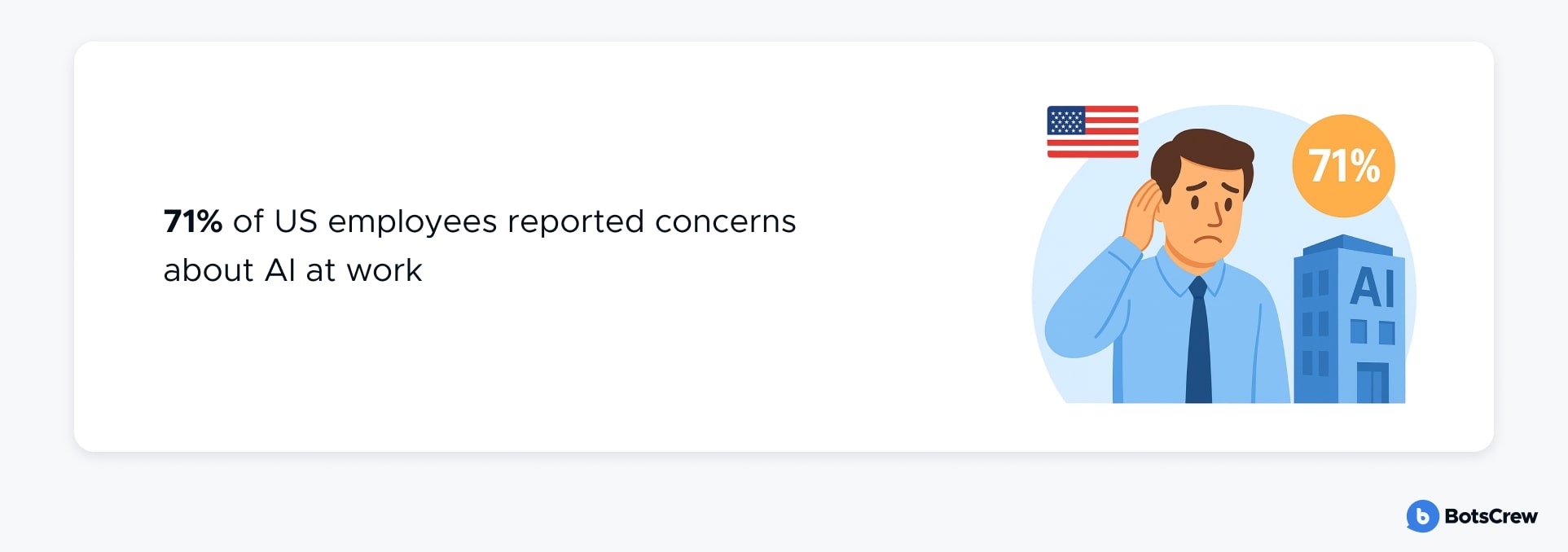
3. Skill and knowledge gaps
Effectively bridging skill gaps through comprehensive training is essential. In a 2023 Economist Impact survey, only 17% of employees reported receiving adequate training in generative AI, indicating substantial room for improvement.
Providing targeted, practical training resources ensures employees can confidently and effectively use AI tools, driving higher adoption and satisfaction.

4. Trust, privacy, and ethical concerns
Building trust through transparency and ethical safeguards is non-negotiable.
According to Kayako's research, both employees and customers frequently express concerns over data privacy and potential bias, which significantly slows adoption. Demonstrating robust privacy measures and clearly communicating AI decision-making processes can alleviate these concerns and boost user confidence.
5. Process and integration issues
Sometimes the AI agent isn’t seamlessly integrated into existing workflows or is hard to access, creating friction. If using the AI is inconvenient or the use case isn’t clear, users will revert to old habits. Aligning AI solutions with users’ day-to-day processes is crucial to drive usage.
21% of companies using gen AI have fundamentally redesigned workflows. Workflow redesign emerged as the single most important attribute correlated with improved earnings before interest and taxes (EBIT). McKinsey & Company
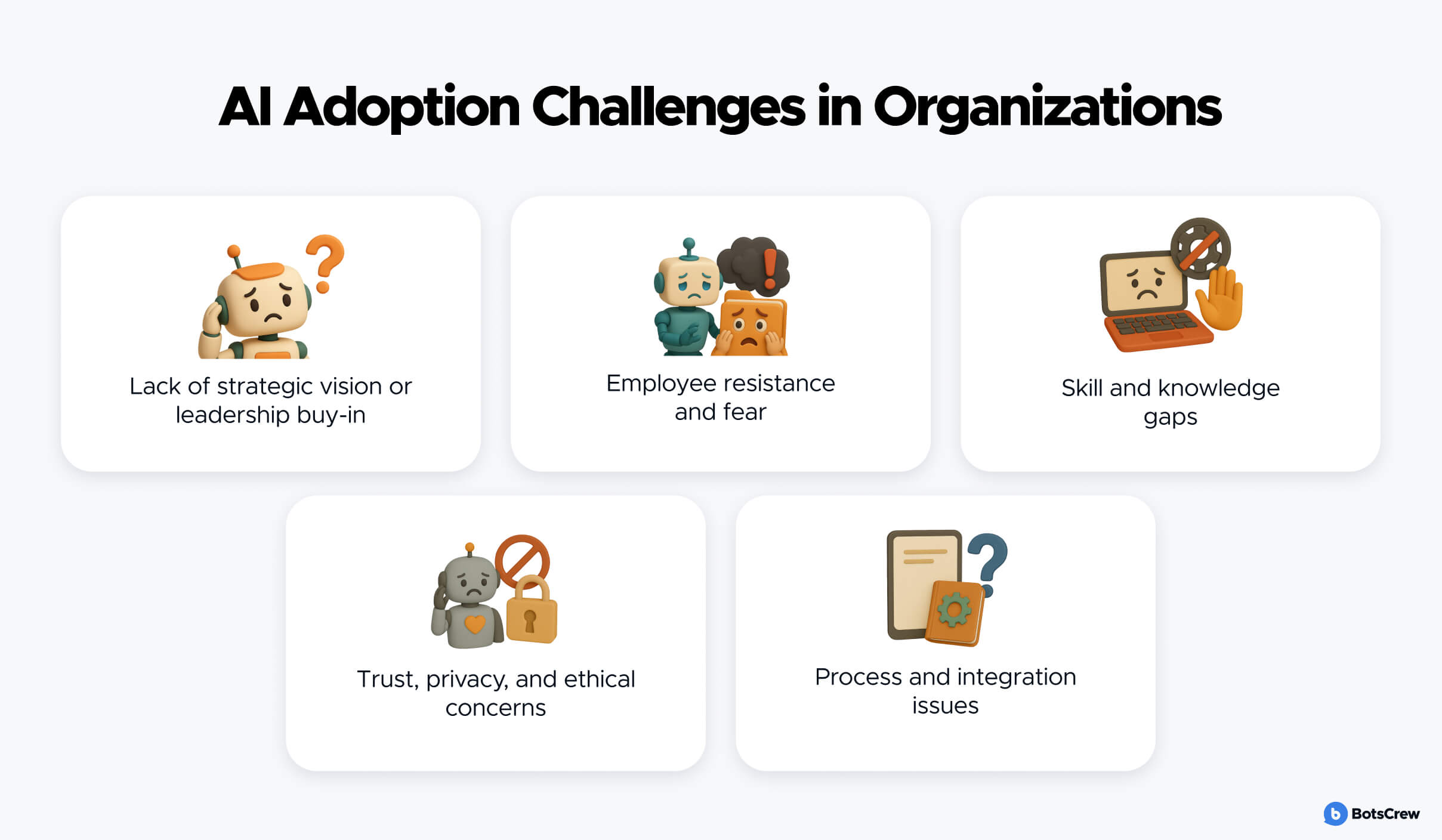
If organizations do not effectively address these AI adoption challenges, powerful AI tools risk being underutilized, delivering minimal benefit, and failing to achieve intended outcomes. Recognizing these consequences underscores the necessity of implementing the strategic approaches detailed below.
Want to ensure a successful AI rollout in your organization?
📩 Book a free consultation with our AI adoption experts to discuss your roadmap and key challenges.
Change Management Strategies for AI Implementation
AI implementation is a change management exercise that reshapes processes and roles while tackling AI implementation challenges like resistance, skill gaps, and misaligned expectations.
Leaders must manage it as a transformative organizational shift, using structured strategies to ensure stakeholder buy-in, clear communication, and alignment with business goals. By addressing these challenges with training and transparency, companies can drive successful AI adoption.
Establishing Clear Leadership and Vision
Strong leadership and a clearly articulated vision are essential first steps to avoid AI implementation challenges. Executive sponsorship sets the tone and direction for the entire AI initiative. Leaders must clearly communicate how AI aligns with organizational objectives and demonstrate that it is designed to enhance human work, not replace it.
A committed leadership team ensures proper resource allocation, effective project management, and consistent reinforcement of the AI strategy. When employees see that leaders prioritize and trust the AI solution, they're more likely to embrace it themselves.
Transparent and Proactive Communication
Clear, ongoing communication is critical during an AI rollout. Employees must understand why AI is being introduced, how it will enhance workflows, and what specific benefits it will bring. Organizations should proactively answer common questions about AI's impact on job roles, data privacy, and organizational changes.
Foster open dialogue through regular meetings, Q&A sessions, or virtual town halls. Clearly articulate that AI will handle repetitive tasks, enabling employees to concentrate on higher-value, creative, or strategic responsibilities.
Addressing Employee Fears and Building Trust
Resistance to AI often stems from fear of job displacement or mistrust regarding how automated systems make decisions. Organizations must proactively address these fears:
Open Forums: Host town hall meetings or open forums where employees can voice concerns and receive transparent, reassuring answers.
Ethical and Privacy Safeguards: Clearly outline the ethical frameworks, data governance policies, and bias mitigation measures implemented to ensure responsible AI use.
Positive Case Studies: Share case studies or data-driven success stories showing how AI has improved efficiency and accuracy without displacing jobs.
Early Employee Involvement and Champion Networks
Early involvement of employees can dramatically increase AI adoption success. Identify enthusiastic early adopters and departmental representatives to participate in AI pilot projects. This inclusion not only improves the AI system through valuable feedback but also fosters a sense of ownership among staff.
These early participants often become internal advocates, championing the AI solution among peers. Their endorsement significantly reduces broader organizational resistance and helps create momentum and enthusiasm around the AI initiative.
Gradual and Strategic Rollout
Begin with a pilot project within a single team or focused on a specific function to demonstrate immediate and visible benefits. This phased approach allows your organization to refine both the technology and training programs at a manageable scale, gathering valuable feedback and achieving quick wins.
Publicize early successes internally, showcasing tangible results like increased productivity or reduced errors. When employees observe clear improvements from the pilot team, initial skepticism decreases and anticipation builds for wider adoption.
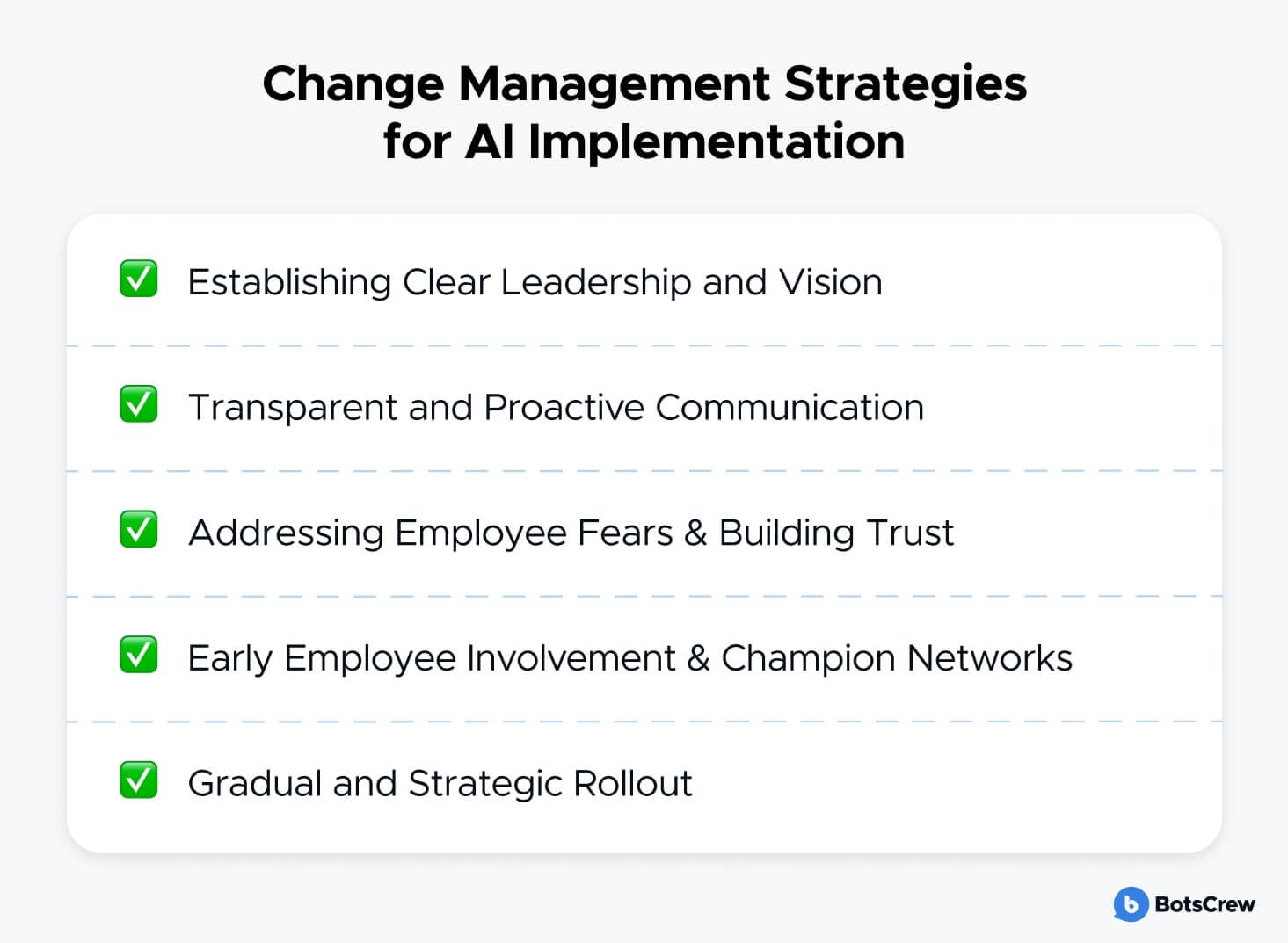
Training and Onboarding Employees to Use AI Agents
Implementing AI agents within an organization is a powerful strategy to enhance productivity, streamline processes, and improve overall efficiency.
The cornerstone of successful AI integration lies in comprehensive employee training and onboarding. Below is a structured approach to effectively train and onboard your employees to confidently and proficiently use AI agents.
Developing a Comprehensive Training Program
Start with the Basics
Begin by introducing all relevant staff to the AI agent through basic training sessions. Clearly explain what the AI is, its key capabilities, and how employees can use it in their day-to-day tasks. Interactive formats such as hands-on workshops and live demos help employees become comfortable with the technology and reduce anxiety.
Provide Role-Specific Examples
Training becomes more effective when it is directly relevant to the employee's role. Tailor sessions to different departments or user groups, demonstrating specific use cases. For instance, show sales teams how AI can streamline proposal drafting, or guide HR teams on using AI to answer common policy-related questions.
Create User-Friendly Documentation
Develop accessible resources like quick-start guides, FAQs, video tutorials, and in-app help tips. Using a free avatar creator can also help personalize training materials, making the learning journey more engaging and relatable for employees. Easy-to-access reference materials allow users to troubleshoot independently, enabling them to learn and solve problems at their own pace, thus reducing dependency on constant support.
Ensuring Ongoing Learning and Support
Training for AI tools shouldn't be a one-time event. Continuous learning opportunities significantly enhance adoption rates and proficiency.
Schedule Follow-up Sessions
Regular follow-up training sessions or refresher courses scheduled weeks or months after initial training can reinforce learning and address evolving needs or updates.
Establish Accessible Support Channels
Establish dedicated communication channels such as Slack or Teams groups, or a helpdesk specifically for AI tool queries. Whether staffed internally or via vendor support teams, prompt responses to queries prevent user frustration and maintain engagement.
Encourage Peer Learning
Promote a culture of peer learning. Initiatives like “AI office hours,” where experienced users or IT staff offer real-time assistance, create a supportive learning environment. Encouraging knowledge sharing and internal mentorship among colleagues helps normalize the AI as a valuable daily resource.
Continuous Feedback and Improvement
Regularly collect user feedback on both training quality and AI tool performance through surveys or feedback forms. Identifying points of confusion or frustration allows for targeted adjustments.
Fostering a Culture of AI Adoption
Managers and team leaders play a crucial role in establishing the norm of using AI tools. Regularly integrate AI into discussions during team meetings or workflow evaluations. Publicly recognizing and rewarding employees who effectively leverage AI reinforces its importance and motivates wider adoption. Sharing success stories through internal communications highlights tangible benefits and encourages others to engage similarly.

Training and Educating Customers to Use AI Agents
Integrating AI agents, such as chatbots or virtual assistants, into customer-facing services can dramatically enhance satisfaction when implemented effectively. Overcoming barriers to AI adoption, such as customer resistance or unfamiliarity, requires thoughtful training and education to ensure customers embrace and benefit from AI-driven services.
Prioritize User-Centric Design
Effective customer adoption starts with intuitive design. AI interfaces must be user-friendly, immediately accessible, and straightforward to navigate:
Clear Visibility: Make AI tools such as chatbots or virtual assistants easy to locate with clearly identifiable icons or prompts.
Natural Interaction: Use plain language and proactive prompts to guide customers, reducing barriers to AI adoption by simplifying engagement.
Clearly introduce the AI agent upon first interaction. For example, when a chatbot initiates a conversation, it might say, "Hi, I’m Ava, your virtual assistant. I can help track orders or answer billing questions!" Setting clear expectations upfront educates users and encourages confident interactions.
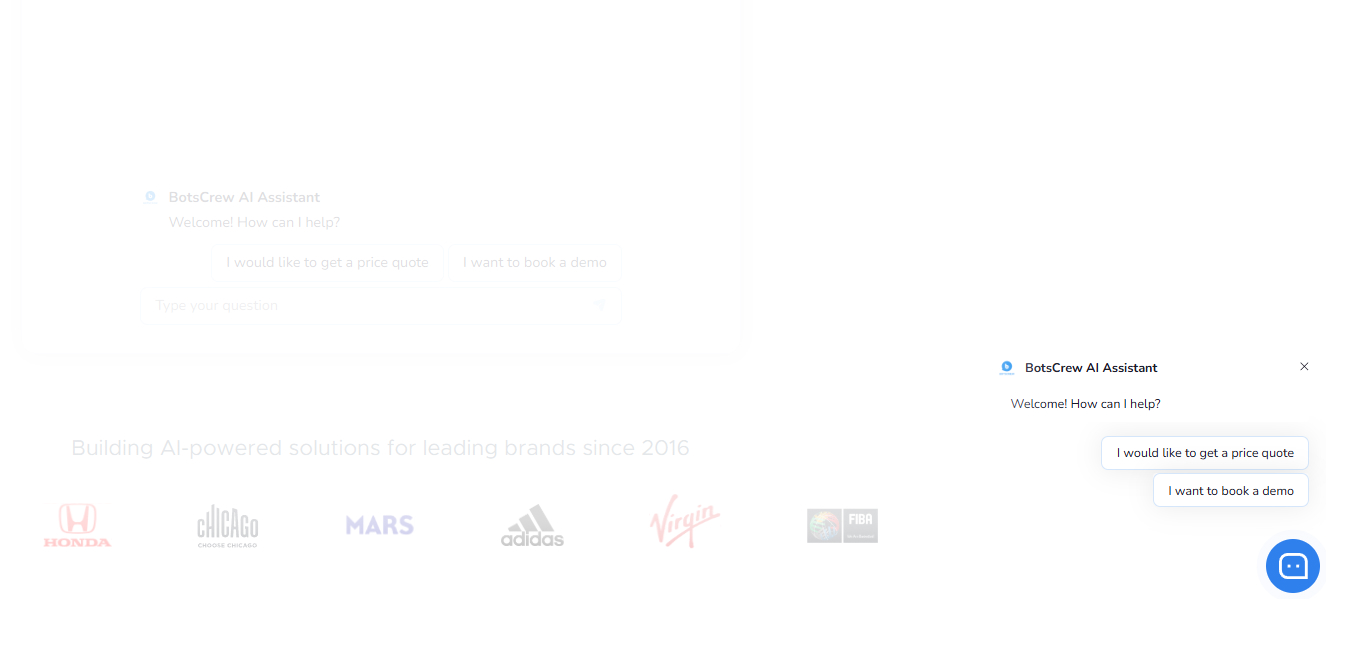
Effective Onboarding Tutorials
For complex AI tools, provide concise onboarding experiences. Short walkthroughs or tooltip guides help users grasp features quickly, addressing barriers to AI adoption like unfamiliarity. Brief, guided tours highlighting key functionalities boost initial usage and sustained adoption.
Strategic Communication and Promotion
Introducing customer-facing AI should be treated like a targeted change management effort:
- Use email newsletters, blog posts, social media, and in-app notifications to broadly communicate AI’s benefits, emphasizing ease of use, 24/7 availability, and personalized assistance. Leveraging ready-made email newsletter templates can speed up the process, ensuring consistent branding and professional communication across all campaigns.
- Simple Instructions: Clearly outline how to interact with the AI through easy-to-follow instructions, quick videos, or engaging visuals (such as GIFs) demonstrating typical AI interactions.
- Transparency and Reassurance: Communicate clearly that human support remains readily available, alleviating customer fears of becoming stuck interacting solely with a bot. Offering easy escalation paths to human agents enhances trust.
Balancing AI Automation with Human Support
A hybrid customer support approach balances AI automation with human intervention:
Easy Human Escalation: Clearly indicate options for reaching human support if the AI cannot resolve a query effectively, thereby minimizing customer frustration.
Educated Support Teams: Ensure customer support teams thoroughly understand AI capabilities and workflows, enabling seamless transitions between AI and human interactions without customers needing to repeat their queries.
Gathering and Utilizing Customer Feedback
Encourage customers to provide feedback on AI interactions. Simple prompts such as “Was this helpful?” offer valuable insights into AI performance and user satisfaction. Use analytics to pinpoint bottlenecks or issues and make informed adjustments.
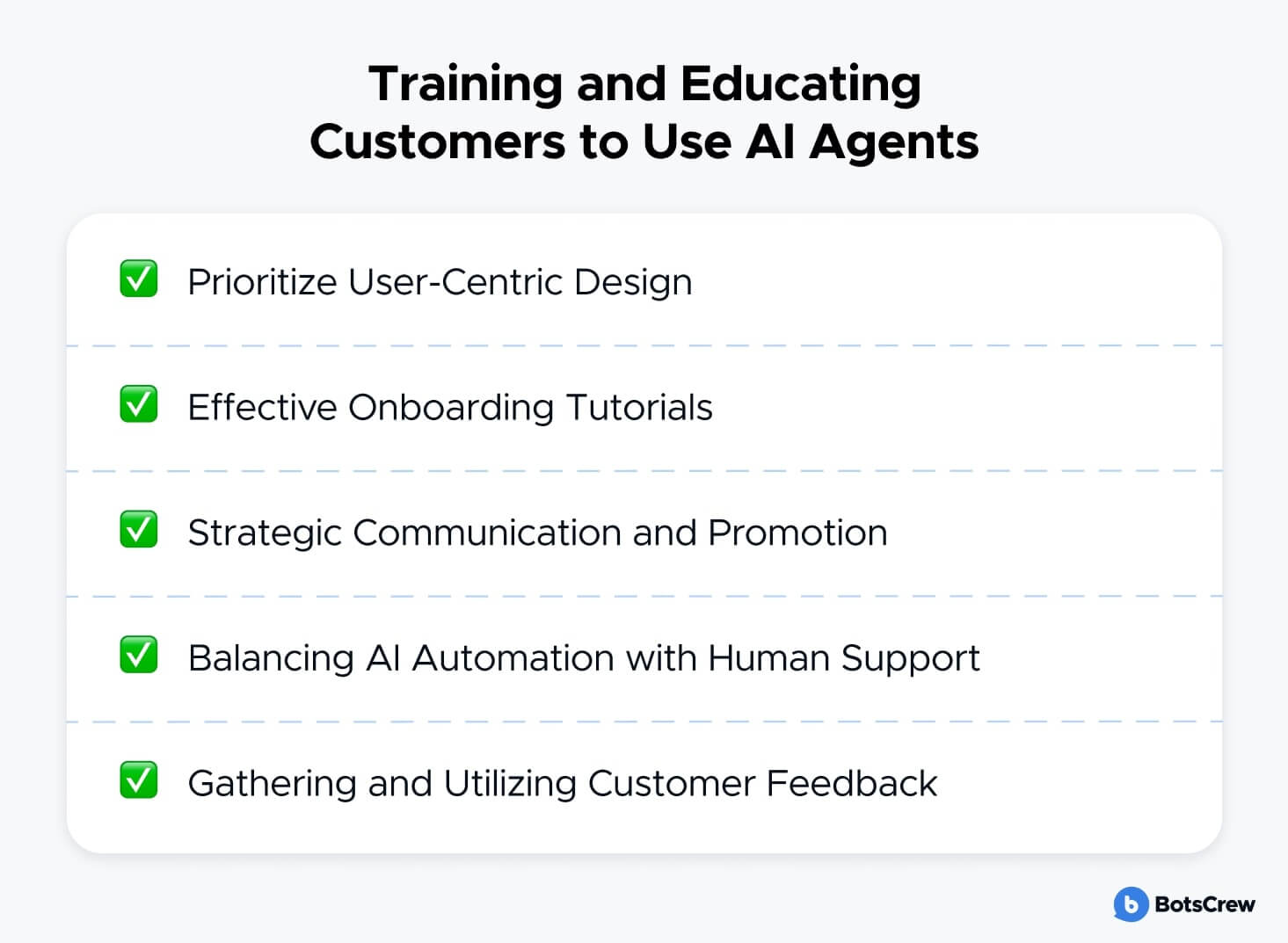
Customer adoption of AI agents hinges on thoughtful design, clear communication, balanced automation, and continuous feedback loops. By proactively educating customers, clearly demonstrating benefits, and maintaining transparency and trust, organizations significantly increase the likelihood that customers will actively embrace AI.
Partnering with Trusted AI Solution Providers: Navigating AI Adoption Successfully
Successfully implementing AI agents within your organization involves navigating technical complexities, organizational change, and user adoption challenges. Enterprise leaders don't have to tackle these challenges alone. Partnering with experienced AI solution providers can significantly simplify and enhance your AI adoption journey.
When to Seek an AI Solution Partner
Recognizing when to engage a trusted AI solution partner is crucial. If your organization is new to AI technology, faces integration hurdles, or struggles to achieve widespread user adoption, seeking external expertise can provide invaluable guidance. An experienced AI partner offers not only technical know-how but also practical strategies for managing the human side of AI integration.
Expertise in Customization and Integration
Customized AI solutions are essential for smooth integration and high user adoption rates. Solution providers, such as BotsCrew, specialize in building AI agents specifically tailored to your organization's unique needs and existing workflows. Rather than adopting a one-size-fits-all solution, custom-built AI solutions fit naturally within daily operations, significantly reducing user friction and enhancing overall acceptance.
Comprehensive Change Management Support
A reliable AI solution provider understands that successful AI implementation extends beyond technological deployment. They recognize the importance of change management and provide comprehensive support to address human factors. Services typically include:
- Assisting in the development of targeted training programs and educational materials.
- Offering best practices specific to the deployed AI solution.
- Facilitating employee engagement early in the AI adoption process through workshops and training sessions.
Continuous Collaboration and Support
A trusted AI partner doesn't just disappear after the initial rollout. Instead, they provide ongoing support and collaboration to continually enhance the AI solution's effectiveness and adoption. This involves:
- Monitoring user engagement and adoption rates.
- Providing data-driven recommendations based on usage analytics and benchmarking insights from similar client implementations.
- Iteratively refining the AI solution based on real-world usage and user feedback.
Through continuous collaboration, partners like BotsCrew help ensure that the AI solutions remain relevant, beneficial, and highly adopted within the organization.
The Importance of a Trusted Advisor
Selecting the right AI partner provides decision-makers with the confidence to successfully navigate the complex journey of AI adoption. Experienced solution providers have insights into industry best practices and common pitfalls. They proactively advise organizations on critical success factors such as user engagement, training effectiveness, and strategic communication, aligning the AI implementation strategy with the organization's culture and operational goals.
Partnering with a trusted AI solution provider significantly enhances your organization's ability to successfully implement and adopt AI technologies. Providers like BotsCrew offer essential expertise in customization, integration, change management, and ongoing collaboration. Selecting the right partner positions your organization not just for successful AI deployment but for sustained, transformative business improvements.
🚀 Ready to improve AI adoption in your enterprise?
Let’s talk. BotsCrew helps companies like yours integrate, onboard, and scale AI agents that actually get used.







